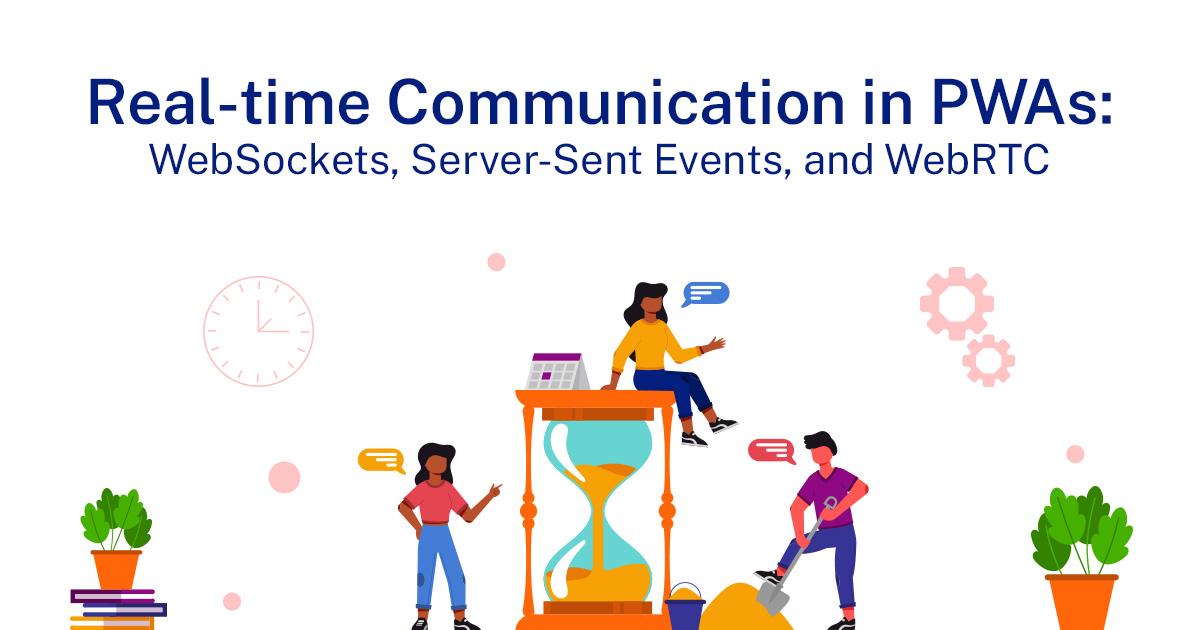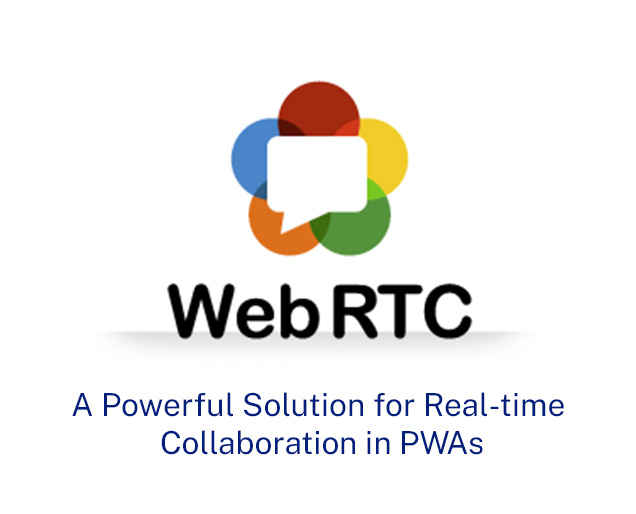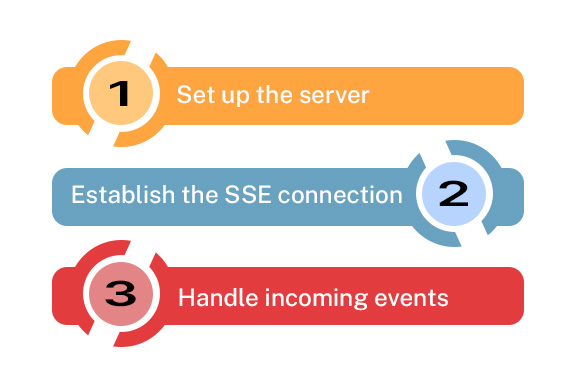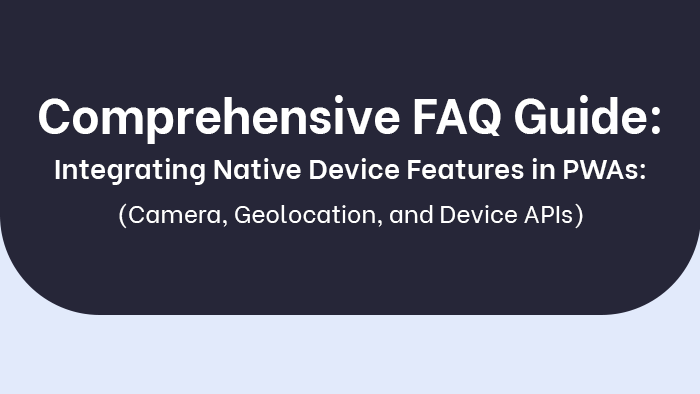
Real-time communication plays a crucial role in Progressive Web Applications (PWAs), enhancing user experience and enabling interactive functionalities.
This article examines the significance of real-time communication in PWAs, focusing on three key technologies: WebSockets, Server-Sent Events, and WebRTC.
By delving into their mechanisms, advantages, limitations, and comparative analysis, this study aims to provide developers with comprehensive insights into implementing real-time communication in PWAs.
The exploration of these technologies will shed light on their respective roles in facilitating seamless and efficient real-time data transmission within PWAs.
Key Takeaways
- Real-time communication is crucial in PWAs, allowing for instant updates and collaboration.
- WebSockets play a significant role in enabling real-time communication in PWAs.
- Server-Sent Events offer an alternative approach for real-time updates in PWAs.
- WebRTC is a powerful technology for implementing real-time audio and video communication in PWAs.
The Importance of Real-time Communication in PWAs
The significance of real-time communication in Progressive Web Applications (PWAs) lies in its ability to facilitate instant and continuous data exchange between the client-side and server-side. This enhances user experience and enables efficient interaction.
Real-time communication allows PWAs to update content seamlessly without requiring users to manually refresh the page. This provides a more dynamic and responsive browsing experience. It is particularly advantageous for applications that require frequent updates such as messaging platforms, collaborative editing tools, or live streaming services.
One of the key advantages of real-time communication in PWAs is its ability to improve user engagement. By enabling instant updates, notifications can be pushed to users in real time, keeping them informed about important events or updates. This enhances the overall user experience and increases user retention and satisfaction.
Furthermore, real-time communication enables efficient interaction between clients and servers. Traditional web applications often rely on periodic requests from clients to fetch updated data from servers. In contrast, with real-time communication technologies like WebSockets or Server-Sent Events (SSE), data can be pushed from the server to clients instantly whenever there are changes or updates available. This eliminates unnecessary network traffic and reduces latency, resulting in faster response times.
However, implementing real-time communication in PWAs comes with its own set of challenges. One challenge is ensuring compatibility across different browsers and devices since not all browsers fully support all real-time communication technologies. Additionally, managing large-scale deployments where thousands or even millions of concurrent connections need to be handled efficiently requires careful planning and optimization.
Despite these challenges, the advantages offered by real-time communication make it an essential component of modern PWAs. Its ability to provide instant data exchange between clients and servers enhances user experience while enabling efficient interaction for a wide range of applications.
Understanding Websockets and Their Role in Pwas
Websockets serve an essential function in progressive web applications by enabling bi-directional, low-latency communication between clients and servers. They are a protocol that provides full-duplex communication channels over a single TCP connection, allowing real-time data transfer between the client and server without the need for continuous polling.
- Efficient Data Transmission: Websockets implement a persistent connection that remains open as long as needed, eliminating the need to establish a new connection for each request. This reduces latency and overhead associated with establishing multiple connections, resulting in more efficient data transmission.
- Real-Time Updates: With websockets, both the client and server can send messages to each other at any time, enabling real-time updates of data. This is especially useful for applications such as chat systems, collaborative editing tools, or live dashboards where instant updates are crucial.
- Improved User Experience: Real-time communication through websockets enhances user experience by providing instant feedback and eliminating the need for manual page refreshes. Users can receive immediate notifications or updates without interrupting their workflow or losing context within the application.
The implementation of websockets involves utilizing specific libraries or frameworks on both the client-side and server-side to establish and manage WebSocket connections effectively. These libraries handle tasks such as opening connections, sending/receiving messages securely, handling errors gracefully, and closing connections when necessary.
Below is an example of WebSocket initialization in JavaScript for beginners:
// Creating a WebSocket instance
const socket = new WebSocket(‘wss://example.com/socket’);
// Handling the connection open event
socket.addEventListener(‘open’, (event) => {
console.log(‘WebSocket connection opened.’);
// Send a message when the connection is established
socket.send(‘Hello, server!’);
});
// Handling messages from the server
socket.addEventListener(‘message’, (event) => {
console.log(‘Message from server:’, event.data);
});
// Handling errors
socket.addEventListener(‘error’, (event) => {
console.error(‘WebSocket error:’, event);
});
// Closing the WebSocket
socket.addEventListener(‘close’, (event) => {
if (event.wasClean) {
console.log(‘WebSocket closed cleanly, code:’, event.code, ‘reason:’, event.reason);
} else {
console.error(‘WebSocket connection died’);
}
});
here’s an example of using WebSocket with advanced options, including custom protocols and subprotocols:
const socket = new WebSocket(‘wss://example.com/socket’, [‘protocol1’, ‘protocol2’]);
socket.binaryType = ‘arraybuffer’; // Set binary data type
socket.addEventListener(‘open’, (event) => {
console.log(‘WebSocket connection opened with protocols:’, socket.protocol);
// Implement custom logic for handling different protocols here
});
socket.addEventListener(‘message’, (event) => {
if (event.data instanceof ArrayBuffer) {
// Handle binary data
const dataView = new DataView(event.data);
// Advanced binary data processing
} else {
// Handle text data
console.log(‘Message from server:’, event.data);
}
});
// Implement advanced error handling and reconnect strategies for experts
Exploring Server-Sent Events for Real-time Updates in PWAs
Server-Sent Events (SSE) provide an alternative technology for achieving real-time updates in progressive web applications. SSE is a unidirectional communication channel that allows servers to send event streams directly to clients over HTTP. This approach eliminates the need for continuous polling by the client, resulting in improved efficiency and reduced server load.
By using SSE, developers can enhance user engagement in PWAs as real-time updates are delivered seamlessly without requiring constant requests from the client. This ensures that users receive timely information and updates without any manual intervention or page reloads.
Furthermore, SSE also benefits server resources optimization. Unlike Websockets where bidirectional communication is established with persistent connections, SSE relies on a single connection between the client and server. The server only needs to handle one open connection per client rather than maintaining multiple connections simultaneously. This significantly reduces resource consumption on both ends, leading to better scalability and performance.
SSE leverages the EventSource API which provides a simple way for clients to listen for events sent by the server. Through this API, developers can define event types and associated actions on how clients should respond when receiving specific events. These events can carry various types of data such as JSON payloads or plain text messages.
Leveraging WebRTC for Real-time Audio and Video Communication in PWAs

Leveraging the WebRTC technology allows for seamless and efficient audio and video transmission in progressive web applications, enhancing the overall user experience. WebRTC (Web Real-Time Communication) is an open-source project that enables real-time communication capabilities within web browsers. It provides a set of APIs and protocols that facilitate peer-to-peer communication between browsers without the need for any external plugins or software installations.
Using WebRTC in PWAs brings several advantages, including low latency, high-quality audio and video streaming, and cross-platform compatibility. With WebRTC, users can engage in real-time communication directly from their web browser, eliminating the need for separate communication apps or plugins.
Here are three important aspects to consider when leveraging WebRTC in PWAs:
- Security considerations: When implementing WebRTC in PWAs, security should be a primary concern. Since this technology allows direct peer-to-peer communication, it is essential to protect user privacy and prevent unauthorized access to audio/video streams. Implementing secure signaling protocols (e.g., HTTPS) and encryption techniques can help ensure data confidentiality and integrity during transmission.
- WebRTC data channel: In addition to audio/video transmission, WebRTC also provides a data channel that enables bidirectional data transfer between peers. This feature can be leveraged to create interactive real-time applications such as file sharing or collaborative editing tools within PWAs.
- Compatibility with different devices: Another advantage of using WebRTC in PWAs is its compatibility across various devices and platforms. Whether users access the PWA from desktops, laptops, smartphones, or tablets running different operating systems (e.g., Windows, macOS, Android), they can still benefit from real-time audio/video communication seamlessly.
Below is a simplified example of setting up WebRTC for beginners:
// Create a new RTCPeerConnection
const peerConnection = new RTCPeerConnection();
// Get user media (camera and microphone)
navigator.mediaDevices.getUserMedia({ video: true, audio: true })
.then((stream) => {
// Add the user media stream to the peer connection
stream.getTracks().forEach(track => peerConnection.addTrack(track, stream));
})
.catch(error => {
console.error(‘Error accessing user media:’, error);
});
// Implement signaling for beginners to exchange SDP offers and answers
here’s an example of setting up a WebRTC data channel for low-latency data transfer:
// Create a new RTCPeerConnection
const peerConnection = new RTCPeerConnection();
// Create a data channel for advanced data transfer
const dataChannel = peerConnection.createDataChannel(‘myDataChannel’, {
ordered: false, // Unordered delivery
maxRetransmits: 0 // No retransmissions (low latency)
});
dataChannel.addEventListener(‘open’, () => {
console.log(‘Data channel opened.’);
// Implement advanced data transfer logic here
});
dataChannel.addEventListener(‘message’, (event) => {
console.log(‘Data received:’, event.data);
});
// Implement advanced signaling for experts to exchange SDP offers and answers
Advantages and Limitations of WebSockets in PWAs
This discussion will focus on the advantages and limitations of WebSockets in PWAs, specifically in relation to real-time data transfer, scalability, and performance.
Real-time data transfer is a crucial aspect for many modern applications as it allows for instant communication and updates between clients and servers.
Scalability refers to the ability of an application or system to handle increased workload and traffic efficiently.
Performance relates to how well a system performs under various conditions such as high user load or limited network resources.
Real-Time Data Transfer
Real-time data transfer is a crucial aspect of real-time communication in PWAs, facilitating the instantaneous exchange of information between clients and servers. This functionality is particularly important for real-time chat applications where users expect immediate responses and updates. The use of websockets, server-sent events (SSE), and WebRTC are common techniques employed to achieve real-time data transfer in PWAs.
Websockets allow for bidirectional communication channels between clients and servers, enabling real-time data transfer without the need for constant requests from clients.
Server-sent events provide a unidirectional stream of data from the server to the client, allowing for efficient and continuous updates.
WebRTC enables peer-to-peer communication between browsers, ideal for scenarios such as video conferencing or file sharing.
To ensure seamless real-time communication, proper data synchronization mechanisms must be implemented to maintain consistency across all connected clients.
Scalability and Performance
Scalability and performance are critical considerations in ensuring the efficient and effective operation of data transfer mechanisms within real-time communication systems. Real-time communication systems face scalability challenges due to the need to handle a large number of concurrent connections and deliver data in real-time.
As the user base grows, these systems must be able to scale horizontally by adding more servers or nodes to accommodate increased traffic. Additionally, performance optimization techniques play a crucial role in achieving high-speed data transfer within real-time communication systems. Techniques such as caching, compression, load balancing, and minimizing database queries can enhance system performance.
Implementing efficient algorithms for message routing and delivery can also improve overall system performance. Scalability challenges and performance optimization techniques should be carefully considered when designing and implementing real-time communication systems to ensure smooth and reliable data transfer.
How Server-Sent Events Enhance User Experience in PWAs
This discussion explores the ways in which Server-Sent Events (SSE) enhance user experience in Progressive Web Applications (PWAs).
One key advantage of SSE is the ability to provide instant data updates to users, allowing for real-time information without the need for manual refreshes.
Additionally, SSE helps reduce network latency by establishing a persistent connection between the server and the client, enabling faster data transmission and retrieval.
Lastly, SSE enables seamless real-time notifications, alerting users immediately when new information or updates are available.
Instant Data Updates
The ability to receive instant data updates is a crucial aspect of real-time communication in PWAs. Real time data synchronization ensures that the information displayed on a PWA is always up-to-date and accurate. It allows users to view the latest content without having to manually refresh the page, providing a seamless and interactive user experience.
Dynamic content updates enable PWAs to deliver personalized and relevant information to users in real time. This feature can be particularly useful for applications that require real-time notifications or live updates, such as messaging apps or social media platforms.
Reduced Network Latency
Reduced network latency plays a pivotal role in improving the performance and responsiveness of web applications. It ensures that data is transmitted quickly and efficiently, which is crucial for providing a seamless user experience with faster response times. Network latency refers to the time it takes for data packets to travel from one point to another over a network.
By reducing latency, web applications can enhance real-time communication. This allows for instant data updates and enhanced interactivity, which is especially important for applications that rely on real-time data synchronization or require fast response times. Examples of such applications include online gaming, video streaming, or collaborative tools.
Minimizing delays in transmitting and receiving data contributes significantly to enhancing the overall user experience of web applications. It allows for smoother interactions and improved performance, making the applications more efficient and user-friendly.
Seamless Real-Time Notifications
Seamless real-time notifications play a crucial role in providing users with timely updates and information without any noticeable delays. These notifications are an essential feature of modern applications, enabling effective communication between the application and its users.
Real-time messaging allows for instant transmission of messages from one user to another, ensuring rapid and efficient communication. Push notifications further enhance this capability by allowing applications to send updates directly to users’ devices, even when they are not actively using the application. This enables users to stay informed about important events and updates in real-time, enhancing their overall experience.
WebRTC: A Powerful Solution for Real-time Collaboration in PWAs

WebRTC, a powerful and versatile technology, provides an effective solution for real-time collaboration in progressive web applications (PWAs). With its real-time communication capabilities, WebRTC enables seamless and interactive collaboration among users.
One of the key features of WebRTC is its ability to support real-time screen sharing. This feature allows users to share their screens with others in real time, enabling remote teams to work together more efficiently.
In addition to facilitating real-time screen sharing, WebRTC also offers robust security measures for ensuring secure communication in PWAs. It incorporates encryption protocols such as Secure Real-time Transport Protocol (SRTP) and Datagram Transport Layer Security (DTLS) to protect data transmission and prevent unauthorized access. These security measures ensure that sensitive information shared during real-time collaboration remains confidential.
Moreover, WebRTC provides various APIs that allow developers to implement secure authentication mechanisms within PWAs. This ensures that only authorized users can participate in collaborative sessions and access shared content. Additionally, WebRTC supports end-to-end encryption, which means that the communication channels between users are encrypted from start to finish, further enhancing the security of real-time collaboration.
Overall, WebRTC’s real-time communication capabilities and robust security measures make it an ideal solution for enabling effective collaboration within PWAs. Its ability to facilitate real-time screen sharing enhances remote teamwork by allowing users to seamlessly share their screens with others. Furthermore, its strong encryption protocols and support for secure authentication ensure that sensitive information exchanged during collaborative sessions remains protected.
Comparing WebSockets, Server-Sent Events, and WebRTC for PWAs
This discussion aims to compare the efficiency of data transfer, compatibility across platforms, and real-time collaboration capabilities offered by WebSockets, Server-Sent Events, and WebRTC in the context of Progressive Web Applications (PWAs).
The efficiency of data transfer refers to the speed and effectiveness with which these technologies facilitate the exchange of information between client and server.
Compatibility across platforms evaluates how well these technologies function on different devices and operating systems.
Lastly, real-time collaboration capabilities examine their ability to support seamless communication and interaction between multiple users in real time.
Efficiency of Data Transfer
Efficiency of data transfer can be evaluated through the analysis of factors such as bandwidth consumption and latency in real-time communication technologies like WebSockets, Server-Sent Events, and WebRTC. These technologies aim to optimize the use of network resources by implementing various techniques such as data compression and bandwidth optimization.
- Data Compression: This technique reduces the size of transmitted data by encoding it using algorithms like gzip or deflate. By compressing the data before sending it over the network, bandwidth consumption is minimized, leading to improved efficiency in data transfer.
- Bandwidth Optimization: Real-time communication technologies employ strategies to optimize bandwidth usage. These include reducing unnecessary overheads, prioritizing essential information transmission, and implementing adaptive streaming techniques that dynamically adjust video quality based on available network conditions.
- Caching Mechanisms: Caching mechanisms store frequently accessed data closer to end-users, reducing the need for repeated data transfers. This reduces both latency and bandwidth consumption during subsequent interactions.
Compatibility Across Platforms
Compatibility across platforms can significantly impact the usability and reach of real-time communication technologies in various contexts. In today’s interconnected world, where individuals use a wide range of devices and operating systems, ensuring cross-platform support becomes crucial for seamless communication experiences.
Real-time communication technologies, such as WebSockets, Server-Sent Events (SSE), and WebRTC, rely on platform compatibility to enable effective data transfer between different devices and applications. By supporting multiple platforms including desktops, mobile devices, and web browsers, these technologies allow users to communicate in real-time regardless of their preferred device and operating system.
Cross-platform compatibility not only enhances user experience but also expands the potential reach of real-time communication technologies by accommodating a diverse range of users with varying technology preferences. Therefore, prioritizing platform compatibility is essential for maximizing the usability and adoption of real-time communication technologies.
Real-Time Collaboration Capabilities
Real-time collaboration capabilities play a vital role in enhancing communication and productivity in web applications.
One important aspect is real-time document editing, which allows multiple users to edit the same document simultaneously. This feature enables teams to collaborate seamlessly and eliminates the need for constant file sharing and version control.
Another essential capability is collaborative whiteboarding, which provides a shared space for brainstorming, planning, and visualizing ideas. Users can draw, write, add images or shapes, and see changes made by others in real time. Collaborative whiteboarding fosters creativity and facilitates effective teamwork by allowing everyone to contribute their thoughts visually.
These features enhance real-time communication in PWAs by enabling efficient collaboration among team members regardless of their physical location.
- Real-time document editing
- Collaborative whiteboarding
- Simultaneous multi-user interaction
Implementing Real-Time Communication With Websockets in Pwas
One approach to enabling real-time communication in Progressive Web Applications (PWAs) is through the implementation of Websockets, which provide a persistent and bidirectional connection between the client and server. Websockets have several advantages when it comes to handling real-time updates in PWAs.
Firstly, Websockets allow for real-time data transfer without the need for constant polling from the client. This means that instead of repeatedly sending requests to check for updates, the server can push new data to the client as soon as it becomes available. This significantly reduces latency and improves overall performance.
Secondly, Websockets support bi-directional communication, allowing both the client and server to send messages at any time. This makes it ideal for collaborative applications where multiple users need to interact with each other in real-time. For example, in a chat application implemented using Websockets, messages sent by one user are instantly received by all other connected users.
Furthermore, since Websockets maintain a persistent connection between the client and server, they are well-suited for scenarios that require continuous streaming of data or frequent updates. This makes them particularly useful for applications such as stock tickers or live sports scores where real-time information needs to be constantly updated.
Step-by-step Guide to Integrating Server-Sent Events in PWAs

A step-by-step guide for integrating Server-Sent Events in Progressive Web Applications (PWAs) involves establishing a unidirectional connection between the client and server, allowing the server to push real-time updates to the client as soon as they occur. Server-Sent Events (SSE) is an efficient approach for implementing real-time communication in PWAs.
To effectively implement SSE, developers should follow these steps:
- Step 1: Set up the server: The first step is to configure the server to support SSE by specifying the appropriate content type header and event stream format. This typically involves setting ‘text/event-stream’ as the content type and creating an endpoint that generates a continuous stream of events.
- Step 2: Establish the SSE connection: On the client-side, establish a connection with the server using JavaScript’s EventSource API. By creating a new EventSource object and providing it with the URL of the SSE endpoint, developers can initiate a continuous connection that listens for incoming events from the server.
- Step 3: Handle incoming events: Once connected, developers need to define event listeners on the client-side to handle incoming events received from the server. These listeners can be customized based on specific event types or data payloads sent by the server. By processing these events, developers can update their PWAs in real-time.
Efficient implementation of SSE requires careful consideration of various factors such as minimizing network overhead, handling reconnections gracefully, and optimizing event streaming mechanisms. Troubleshooting common issues with SSE often involves debugging connectivity problems or ensuring proper formatting of event streams.
Best Practices for Implementing WebRTC in PWAs
Efficient implementation of WebRTC in Progressive Web Applications (PWAs) involves following best practices that optimize the utilization of real-time communication channels and ensure seamless connectivity between peers.
WebRTC is a powerful technology that enables real-time audio, video, and data communication directly between web browsers without the need for plugins or external software. However, there are several challenges associated with implementing WebRTC in PWAs.
One of the main challenges is optimizing WebRTC performance. This includes minimizing latency, maximizing bandwidth utilization, and ensuring smooth video playback. To achieve this, it is important to consider factors such as network conditions, device capabilities, and codec selection. Implementing adaptive bitrate streaming can help adjust the quality of the media based on network conditions, ensuring a consistent user experience.
Another challenge is dealing with varying browser support for different features of WebRTC. It is crucial to perform thorough testing across different browsers to ensure compatibility and fallback options when certain features are not supported. Additionally, handling potential issues related to firewall traversal and NAT traversal can be complex but necessary for establishing direct peer-to-peer connections.
To optimize performance further, utilizing efficient signaling mechanisms is essential. Signaling protocols like WebSocket or HTTP/2 can be employed for signaling purposes while reducing overhead and improving efficiency.
Overall, implementing WebRTC in PWAs requires careful consideration of various challenges related to performance optimization and compatibility across different platforms and browsers. By following best practices such as adaptive bitrate streaming, thorough testing, efficient signaling mechanisms, and addressing firewall/NAT traversal issues effectively; developers can ensure a seamless real-time communication experience for their users within PWAs.
Conclusion
In conclusion, real-time communication is a vital aspect of Progressive Web Applications (PWAs). By leveraging technologies such as WebSockets, Server-Sent Events, and WebRTC, developers can create dynamic and interactive experiences for users.
While each technology has its advantages and limitations, they all contribute to the seamless exchange of data in PWAs. Implementing these communication methods requires careful consideration and adherence to best practices.
By doing so, developers can unlock the full potential of real-time communication in PWAs and enhance user engagement like never before.


